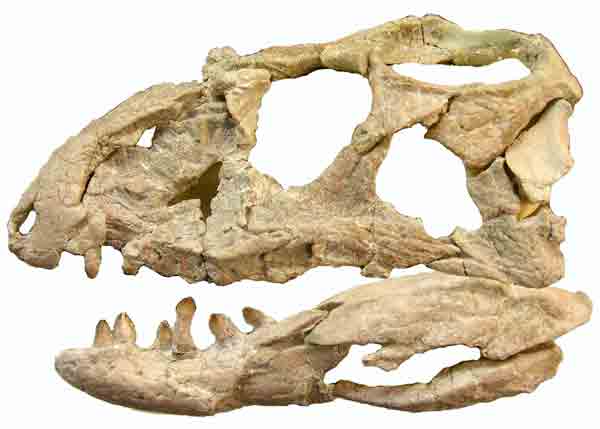Rare Fossil Tooth Thecodont Crocodile mm 2 Prehistoric Reptile Revueltosaurus callenderi Crurotarsa Armored Extinct Mesozoic Triassic Collecting Paleontology Museum, in plexiglass box diam. 3 cm.
Excellent representative collectible fossil specimen difficult to find, complete and in good condition, with excellent front and rear surface details, with evident serration and perfectly preserved enamel.
No restoration at all. Only a piece, as in photos.
Revueltosaurus ("Revuelto's lizard", in Japanese レベルトサウルス) is an extinct genus of prehistoric Crurotarsa (prosauropods Pseudosuchia Crocodilomorpha) lived from the late Triassic period in New Mexico and Arizona, some 215 million years ago.
Less than a meter long, this animal possessed a long tail and a massive body, supported by powerful clawed paws. The body was equipped with a kind of carapace, made up of an armor of elongated plates that partially covered the back and the belly.

The most striking feature of the revueltosaurus, however, was given by the skull: this was really great in relation to the rest of the body, and could reach a length of twenty centimeters. Very large, however, the skull was rather light due to the large anti-orbital windows. The teeth of Revueltosaurus were equally characteristic:
the teeth, in fact, were leaf-shaped and jagged, very similar to those of primitive Ornithischia dinosaurs.
The first known remains of Revueltosaurus were some teeth found in New Mexico, described in 1989 by Adrian Hunt and believed to belong to an ancient Ornithischia dinosaur. Subsequently, similar teeth were found in various locations in the United States, and were attributed to other kinds of Ornithischia dinosaurs. In 2002, other teeth were described as the remains of a new species of Revueltosaurus (R. hunti), and later attributed to another genus (Krzyzanowskisaurus).
Only in 2004 were many more complete remains of Revueltosaurus, in the Petrified Forest of Arizona. Hundreds of bones of this animal have allowed us to understand the true nature of Revueltosaurus:
not a dinosaur, but a distant relative of crocodiles, unlike any other known Archosauria. The dentition similar to that of the Ornithischia dinosaurs, therefore, was simply a phenomenon of evolutionary convergence; this has revolutionized what was known until now on the Ornithischia dinosaurs of the Triassic of North America, Europe and the rest of the world, except for South America, showing that dentition can not be counted to determine whether or not it is a primitive dinosaur. The teeth of Revueltosaurus, in fact, differ from those of other Ornithischia but for the most part are very similar to those of Heterodontosauridae.La discovery of the skeletons of Revueltosaurus has also shed new light on the many isolated teeth found in various parts of North America and previously attributed to Ornithischia dinosaurs (Lucianosaurus, Pekinosaurus, Tecovasaurus). Given that all the presumed Ornithischia of the Triassic are known only from teeth and fragments of jaw (with the exceptions of Eocursor and Pisanosaurus), the discovery has therefore disputed its validity.
Currently, Revueltosaurus is considered a member of the Crurotarsa, the large group of Archosauria today represented only by crocodiles, but that at the beginning of the Mesozoic was much more diversified. Revueltosaurus possessed a mixture of characteristics (the big skull similar to that of the Rauisuchia, the Ornithischia teeth, the armor similar to that of the aetosaurs, once inserted between the Thecodonts, a group fallen into disuse) that have not yet allowed to establish the real kinship of the animal.
The leaf-shaped teeth of Revueltosaurus denote it as an herbivorous animal, which probably tore tufts of foliage and ferns thanks to the powerful limbs. It is not clear what the huge and light skull is for: usually a skull of this kind is compatible with carnivorous attitudes. The dorsal and ventral armor, in any case, had to protect Revueltosaurus from predator attacks such as Coelophysis and Postosuchus.



